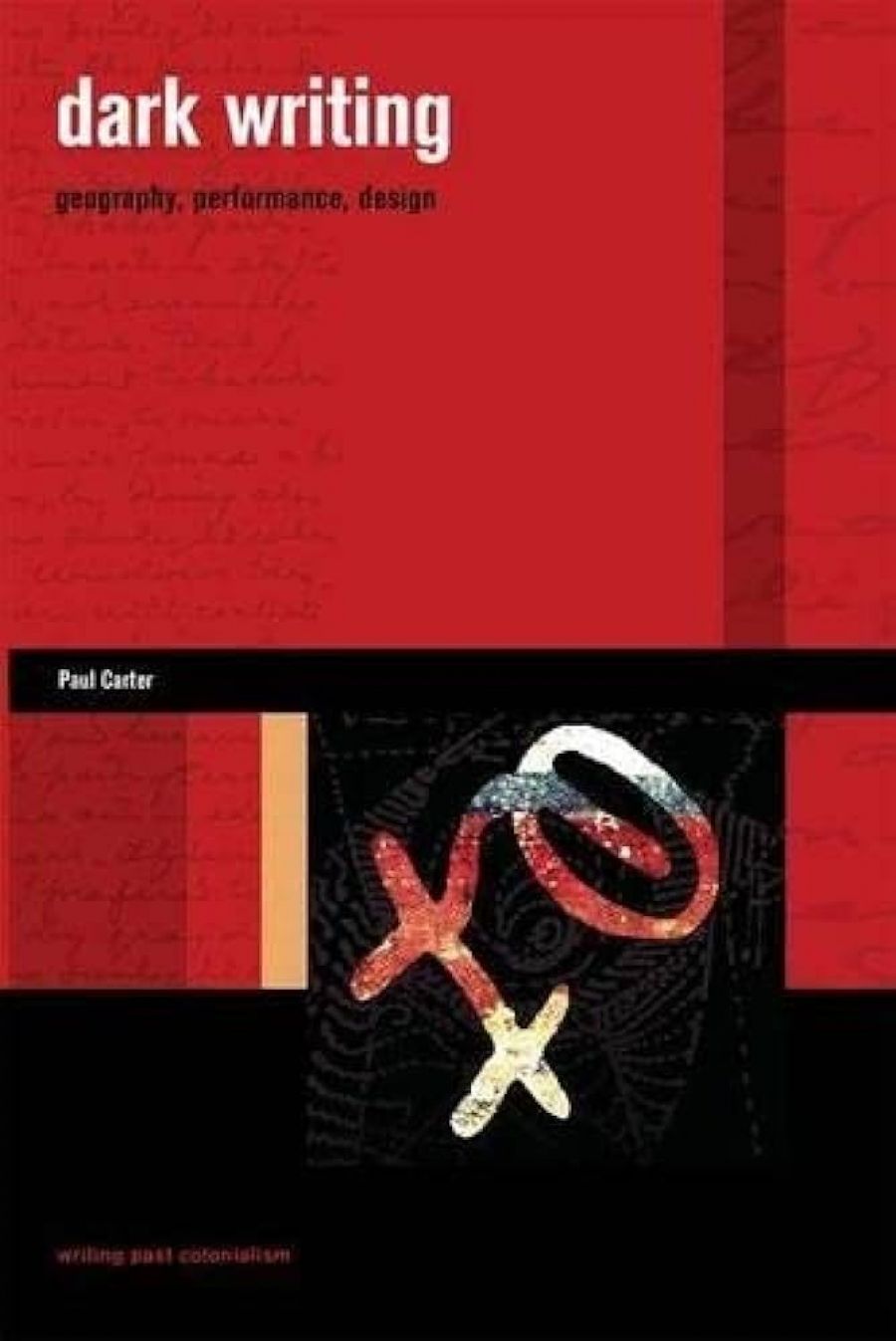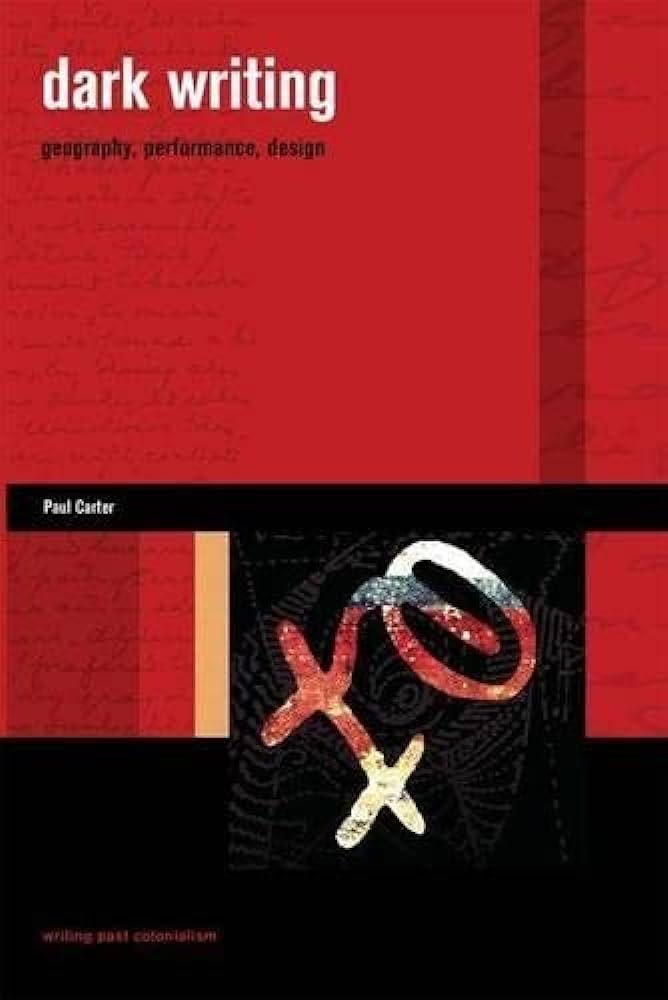
- Free Article: No
- Contents Category: Society
- Review Article: Yes
- Article Title: Canyons of the mind
- Online Only: No
- Custom Highlight Text:
The design of this book is something of a mystery, not least because it presents as a critique of design, seeking to recuperate something that has been lost through ‘the graphic orthodoxies of cartography and architectural drawing’. This lost cultural component, the ‘dark writing’ of Carter’s title, is variously evoked as mythological, participatory, creative and recreative, as a body, a form of movement, a certain kind of substance.
- Book 1 Title: Dark Writing
- Book 1 Subtitle: Geography, performance, design
- Book 1 Biblio: University of Hawaii Press, $64.95 pb, 328 pp, 9780824833121
- Book 1 Cover Small (400 x 600):

- Book 1 Cover (800 x 1200):

As something that can be discerned in everything, yet eludes direct focus, dark writing makes its appearance in this account through processes of association and contra-distinction. It is, with acknowledgment to Gerard Manley Hopkins, ‘the dapple of things’. It suggests itself not in the line of writing, but in the ink blot; not in the message, but the background noise; not in step-by-step progress across the ground, but in the arcs of rhythm traced by human movement. Dark writing is disappearing writing, whose vanishing is the consequence of cultural practices that Carter broadly associates with the Enlightenment and with the colonial impulse to take possession of the world. If you want to learn to read the mystery script, you have to reverse the effects of this heritage: by allowing the landscape to lead you in the direction of choreography rather than cartography, by moving from design to poetics, from geography to mythology, from planning to hieroglyphics. Since the drawing of lines leads to the drawing of conclusions, you must learn to draw differently, so as to allow the dapple of things to emerge.
Putting the issue of design aside for a moment, there is no question that this book has a heart – a heart of darkness, in the illuminating sense that the word acquires through Carter’s techniques of poetic management – and that this is the chapter on the Papunya Tula movement of 1971–72. There, in the story of how a small, broken-down indigenous community in the Western desert saw the genesis of an artistic renaissance that would make a profound impact on the international art world, is a quintessential lesson in how to draw. Or perhaps, how not to draw: how not to be drawn into the imaging habits of consciousness blocked off from the ever-changing choreography of the landscape. This chapter is based on the introduction Carter wrote for the authoritative catalogue of Papunya Tula painting produced by Geoffrey Bardon, the white teacher who instigated the movement, and who played a key role in negotiating its wider reception. The works produced by the indigenous artists of Papunya are consummate examples of dark writing, but it is the white man’s story that Carter feels he needs to tell, since it has been ‘generally overlooked or downplayed’.
Bardon, as the one working at the cultural interface between indigenous and settler traditions of representation, has eyes that become the lens through which different ways of seeing converge. Under his influence, dark writing is lifted from its place in the landscape and takes new forms on squares of canvas that can be transported elsewhere. Bardon represents the possibility of a turning point, away from the geometry and geography of Australia’s colonial heritage; his service to indigenous art might be seen as a form of exculpation for the damage done by servants of the empire. Not that this is explicitly suggested, but the book raises the question of how a repressed or suppressed dimension of human expression can be recovered, and does so in relation to a sustained critique of the repressive influences.
The structural design of Dark Writing is dependent on an almost algebraic lining up of terms according to whether they are conducive or inimical to the mysterious phenomenon that is Carter’s subject. Since the enemies are by definition more conspicuous, much of the book is driven by scatter-gun animosity. This is generally not directed against persons (though Descartes gets more than a few side-swipes), but at practices, casts of mind and modes of knowledge. Geography ‘embraces the myth of scientific description’. Design practice is ‘overridden by the force majeur of axiom-based linearism’. Urban planning is governed by ‘the strong ideological attachment to rectilinear rationalisation’. Architecture, ‘obsessed with foundations’, seeks always to amass, fix and consolidate. The fabric of argument that holds the book together is woven through a set of equations: myth and dreaming are to scientific description as choreography and story are to linear design; an ink blot is to a line of writing as colloidal drifts are to a cartographer’s coastline. I could go on, and Carter does, with an apparently inexhaustible fascination for this pattern of tensions and oppositions.
For all his virtuosity as a writer, Carter’s ancient-mariner-like determination to keep the reader as enthralled with the play of terminologies as he is himself doesn’t always pay off. There were times I wanted to shake the hand off my shoulder and respond with a set of counter-propositions. Yes, but scientists also study dark matter, engage in fuzziology, seek closer acquaintance with chaos and teach the second law of thermodynamics. Yes, but linearity was not born with the Enlightenment, nor did it grow up straight, nor in a European framework of investigation. What about the work of Arabic scholars on optics and rays in the ninth century? Their English followers included John Dee, a mythologically minded astrologer but also the most sophisticated mathematician of the Elizabethan period, and Robert Fludd, whose curvilinear diagrams of the universe pulse with numinous intuition. By habitually badging our own tradition as ‘colonial’ and ‘enlightenment’, aren’t we blinding ourselves to major dimensions of our cultural heritage? Is this helpful, if we’re looking for common ground with indigenous traditions?
The kinds of challenges Carter is raising have to do with the rules of argument. If you disavow linearity and step-by-step reasoning, on what terms are you presenting your case? Perhaps argument is not really the currency here. What’s being offered is closer to a form of poetics, more dependent upon imagistic resonances than on substantiating evidence. Yet there are also philosophical resonances in the thematic design of Dark Writing. The major cultural binaries of Western tradition – Apollonian/Dionysian, Classicism/Romanticism, rationalism/empiricism, materialism/idealism – are echoed variously here, though a more immediate precursor is the set of polarities devised by Deleuze and Guattari in their elaboration of ‘rhizomatics’ (the rhizome, as a labyrinthine growth capable of almost infinite twists and turns, being counterposed to the arborescent or tree-like form branching from a central line). Like other key post-structuralist thinkers, Deleuze and Guattari disavowed binarism only to reintroduce it on a new plane, so as to redraw the axis and re-conceive the dynamics of the polarity.
Carter follows them in his strategy of keeping the axis fuzzy, and paying attention to dynamic interaction rather than states and positions, but makes another kind of journey through his engagement with specific Australian contexts. His work has an applied dimension. The later chapters in Dark Writing are devoted to accounts of redevelopment projects – at Olympic Park in Homebush Bay, North Terrace in Adelaide, and Victoria Harbour in Melbourne – where his role is as a conceptual artist, finding ways to reconfigure the historical layering of public spaces so that they can be experienced as theatres of a continuous present. Given the emphasis on materialities of place throughout the book, it is a practice that might be described as cultural geology.
For me, one of the most memorable images in this overstocked anthology of metaphors is that of the eighteenth-century geologist James Hutton discovering the weirdly perpendicular ‘unconformities’ in rock strata, thus finding himself, according to Carter’s account of it, confronting the visualisation of the invisible, the dark writing of the earth itself, in the violently skewed relationship of its chronological layers. Then there is another twist in the interpretation: this meticulous scientist, with his stated adherence to step-by-step methods of enquiry, has a ‘chemical’ mentality that is somehow porous to the environments he explores. ‘He found himself in looking about himself, in the history of his contacts with the environment.’ I don’t know if this proposition would stand up to scrutiny among those with more specialised knowledge of Hutton and his work, but I am not sure that matters. What does matter is the force of the metaphoric pattern, and its potential to open up the canyons of the mind.


Comments powered by CComment